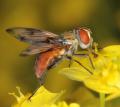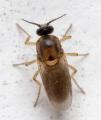Diptera.info :: Family forums :: Syrphidae
|
Odd Syrphus?
|
|
| Chris Webster |
Posted on 16-12-2008 23:15
|
|
Member Location: Reading UK Posts: 31 Joined: 07.07.07 |
These 2 females were seen 28.7.2008, 10.8.2008 in Berkshire, UK. Are they just Syrphus with weak markings? They don't seem to be Parasyrphus sp. |
| Chris Webster |
Posted on 16-12-2008 23:26
|
|
Member Location: Reading UK Posts: 31 Joined: 07.07.07 |
Ah... no picture uploaded!! Trying another way.. |
| Vladimir Davydov |
Posted on 17-12-2008 05:46
|
|
Member Location: Russia,St.-Petersburg Posts: 324 Joined: 01.08.07 |
I saw similar http://diptera.in...ad_id=9524
Vladimir |
|
|
|
| Gerard Pennards |
Posted on 17-12-2008 12:50
|
|
Member Location: Amersfoort Posts: 1914 Joined: 07.06.04 |
Indeed, it is a failure of mother nature in constructing the specimen. Something happened during pupal stage (temperature, moisture etc) and it gave the animal this color and form. It happens often, a lot of times animals with 'failures' die already before hatching, but we also see specimens like this! Greetings Greetings, Gerard Pennards |
|
|
|
| Chris Webster |
Posted on 17-12-2008 22:39
|
|
Member Location: Reading UK Posts: 31 Joined: 07.07.07 |
Thanks Vladimir... your specimen looks just the same. Maybe these are not failures Gerard, if the aberration is not linked with infertility, and if males can recognise them more easily than I can! |
| Gerard Pennards |
Posted on 18-12-2008 09:33
|
|
Member Location: Amersfoort Posts: 1914 Joined: 07.06.04 |
Indeed it's not always linked to infertility, although a lot of times the specimens are not 'fit' enough to compete with normal specimens, especially the males. There are also specimens (for example Parasyrphus punctulatus) of which there are sometimes a lot of intersexes present in spring, which have reduced genital organs and intermediate male-female characters and those are obviously not able to reproduce! greetings Greetings, Gerard Pennards |
|
|
|
| Jump to Forum: |













